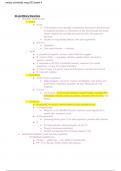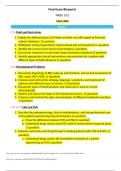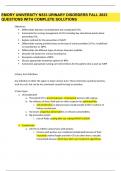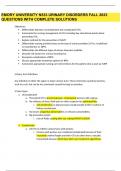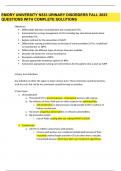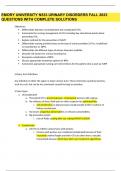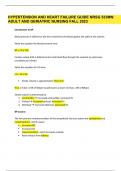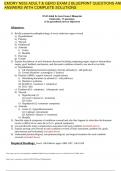Emory University
Latest uploads at Emory University. Looking for notes at Emory University? We have lots of notes, study guides and study notes available for your school.
-
254
- 0
-
10
All courses for Emory University
Popular books Emory University
Latest notes & summaries Emory University
GI and Biliary Disorders ● Hepatitis: inflamed liver ○ Patho ■ Acute ● Viral infection, liver damage, cholestasis: decrease in bile flow due to impaired secretion or obstruction of bile flow through bile ducts (retain substances normally excreted into bile: bile salts and bilirubin) ● Usually no long-lasting effects; liver cells regenerate ■ Chronic ● Hepatitis c ● Can cause fibrosis → cirrhosis ○ Types ■ A: prevent by hygiene, vaccine, wash fruits and veggies ...
C16 Fluid and Electrolytes 1. Explain the different types of IV fluids and their use with regard to fluid and sodium imbalance. (2 question) 2. Distinguish among hypovolemia, hypervolemia and normovolemia (1 question) 3. Identify the normal serum levels of electrolytes (1 question) 4. Discuss the treatment of each hyper/hypo electrolyte imbalance (1 question) 5. Identify appropriate clinical interventions and evaluation for a patient with different types of fluid imbalance (1 question) C...
Emory University NRSG 533 Urine Disorder Handout ANSWERS FALL 2023
Emory University NRSG 533 Urine Disorder Handout ANSWERS FALL 2023
Objectives: Differentiate between uncomplicated and complicated UTIs. Summarize the nursing management of UTIs including key educational points about preventing UTIs. Explain methods for the prevention of CAUTI Differentiate nursing priorities base on the type of urinary problem (UTI vs. Urolithiasis vs Incontinence vs. BPH). Differentiate the different types of urinary diversion available. Describe risk factors for urinary incontinence. Recognize complicatio...
Emory University NRSG 533 Urine Disorder Handout ANSWERS FALL 2023
Objectives: Differentiate between uncomplicated and complicated UTIs. Summarize the nursing management of UTIs including key educational points about preventing UTIs. Explain methods for the prevention of CAUTI Differentiate nursing priorities base on the type of urinary problem (UTI vs. Urolithiasis vs Incontinence vs. BPH). Differentiate the different types of urinary diversion available. Describe risk factors for urinary incontinence. Recognize complicatio...
Introduction to BP. Blood pressure is defined as the force exerted by the blood against the walls of the arteries. Write the equation for blood pressure here: BP = CO x SVR Cardiac output (CO) is defined as the total blood flow through the systemic or pulmonary circulation per minute. Write the equation for CO here: CO = SV x HR Stroke volume is approximately 70mL/min True or False: A HR of 50bpm would lead to a lower CO than a HR of 80bpm Stroke volume is determined by: 1. Contra...
N533 Adult & Gero Exam 2 Blueprint Endocrine- 17 questions (# in parenthesis next to objective) Objectives 1) Briefly summarize pathophysiology of every endocrine organ covered a) Hypothalamus b) Pituitary c) Thyroid d) Parathyroid e) Adrenals i) Cortex ii) Medulla f) Pancreas g) Gonads 2) Explain the pathway of each hormone discussed including originating organ, target or intermediary targets, goal, feedback mechanism, and discussed conditions related to too much or too little. ...
Endocrine Module Learning Objectives 5 Functions of the Endocrine System - Role in reproductive & CNS function - Stimulate growth & development - Sexual reproduction - Maintaining homeostasis - Responding to emergency demands 1. Briefly summarize pathophysiology of every endocrine condition covered (except parathyroid) (1) ○ Disorders of Anterior Pituitary ■ Acromegaly: caused by a benign pituitary adenoma that secretes GH (growth hormone) ● Affects: 4/million adults in US diag...


